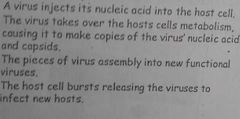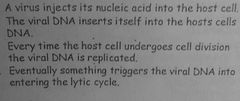![]()
![]()
![]()
Use LEFT and RIGHT arrow keys to navigate between flashcards;
Use UP and DOWN arrow keys to flip the card;
H to show hint;
A reads text to speech;
32 Cards in this Set
- Front
- Back
- 3rd side (hint)
|
Define Taxonomy |
It is the science of classifying according to the inferred relationship among organisms |
|
|
|
What are 2 reasons why organisms are classified? |
They're classified to indentify organisms and to recognize the natural groupings of living things |
|
|
|
Who was the first person to classify organisms using binominal nomenclature? |
Carolus Linnaeus |
|
|
|
What is binominal nomenclature? |
It is giving an organism a two part scientific name in latin
Ex: homo sapiens |
Also provide an example |
|
|
What are they 7 taxa we use today? |
Kingdom, phylum, class, order, family, genus and species |
|
|
|
What are the 6 kingdoms of living things? |
Eubacteria, Archaebacteria, Protista, Fungi, Plantae and Animalia |
|
|
|
What is an example of Eubacteria? |
True bacteria |
|
|
|
What is an example of Archaebacteria? |
Ancient bacteria |
|
|
|
What is an example of Protista? |
Amoeba |
|
|
|
What are the 3 domains? |
Archaea, Bacteria and Eukarya |
|
|
|
Define parasitic bacteria |
Feeds on living organisms |
|
|
|
Define saprophytic bacteria |
Feeds on dead organisms |
|
|
|
Define petidoglycan |
The substance found in cell walls |
|
|
|
Where do Archaebacteria live? |
Hot springs, polar ice caps, oxygen free areas, very salty water |
4 |
|
|
Where do Eubacteria live? |
Fresh water, salt water, land, air, human body |
5 |
|
|
What are 3 reasons why bacteria are so important to earth? |
1. They're decomposers 2. They're "nitrogen fixers" 3. Can be used for human use |
|
|
|
What does nitrogen fixers mean? |
Bacteria can make nitrogen into a form plants can use |
Bacteria |
|
|
What are the 3 types of protists and their common names? |
1. Animal like = protozoa 2. Plant like = algae 3. Fungus like = molds |
|
|
|
What are the 4 types of plant like protists? |
Euglenophytes, Chrysophytes, Diatoms and Sporozoans |
|
|
|
What are 2 things that typically make up a virus? |
1. Nucleic Acid Core (DNA or RNA) 2. Capsid |
|
|
|
Where did the term virus obtain it's name from? |
The latin word poison |
|
|
|
Give examples of bacterial infections |
Lyme Disease Pneumonia Syphilis Chlamydia |
Aim for 4 |
|
|
Give examples of viral infections |
Polio Smallpox Whooping Cough HIV Flu Cold |
Aim for 4 |
|
|
How are bacterial infections treated? |
Antibiotics |
|
|
|
How are viral infections treated? |
Vaccinations |
|
|
|
What is a genus? |
The first part of the scientific name which is always underlined with the first letter being uppercase. It is often the Latin translation of the common name |
|
|
|
What is a species? |
The second part of the scientific name is also underlined but all of the letters are lowercase |
|
|
|
What are the two advantages of binomial nomenclature? |
1. It provides a common language for all scientists. 2. It indicates similarities in anatomy, embryology and ancestry. |
|
|
|
A capsid makes up how much of a virus? |
95% |
|
|
|
What is a bacteriophage? |
A type of virus that infects bacteria |
|
|

What virus cycle is this? |
Lytic Cycle |
|
|

What virus cycle is this? |
Lysogenic Cycle |
|

